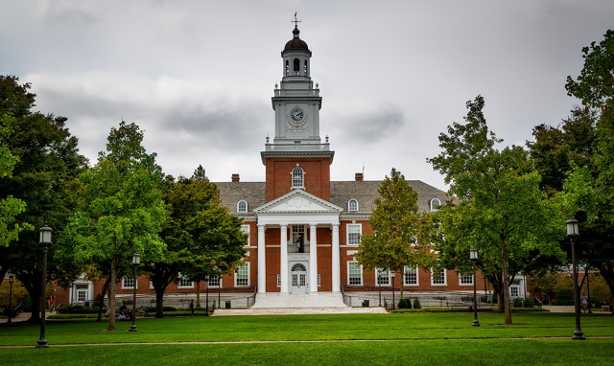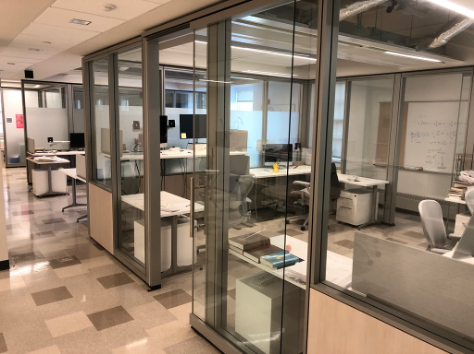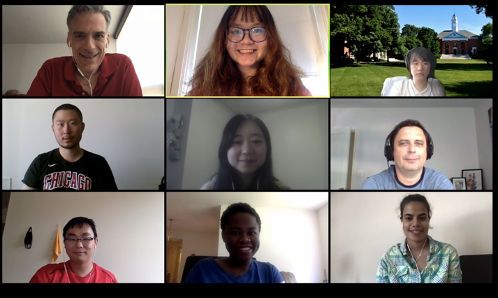On a lovely spring day, as I was lying on the Skinner Green and soaking up the sun, my phone buzzed. It was an email from the Center for Sustainable Nanotechnology (CSN) regarding my application for their Summer Undergraduate Research Experience (SURE) program. My heart dropped a beat when I glimpsed the content of the email and words could not describe enough how excited I was to hear that I would be joining a computational chemistry lab at Johns Hopkins University.

I first got interested in theoretical chemistry last fall when I had an opportunity to work on a polymer-related project using computational techniques at Mount Holyoke College. I decided to look for summer research programs related to this field. Fortunately, I had a classmate who suggested I apply for the CSN SURE. As I checked out the information on CSN computational labs, I was especially excited about the amazing work of Dr. Rigoberto Hernandez at Johns Hopkins, and I was eager to get some hands-on experiences with a nanoparticle-related project.Receiving that offer email from the CSN was genuinely delightful and excited me more than any of my other opportunities. I began to plan some fancy activities for my trip to Baltimore and could not help spamming my friends with all my silly thoughts about the summer at Johns Hopkins. I imagined walking along the hallway of graduate student offices in the Macaulay building, talking to graduate students about their Ph.D. life, getting started on an interesting project in the office, and surrounding myself with true scientists. What an awesome experience to have!

But life always has unpredictable turns. The COVID-19 pandemic hit the States in the middle of the spring semester. Schools shut down, laboratories closed, and many internship plans began to fall apart. The attack of the virus turned every single life upside down and mine was no exception. Amid the chaos, I got the wonderful news that the CSN program was continuing virtually. Even better, although labs were closed, since the resources required for theoretical chemistry are mainly computers and software, I would still be able to do actual full-time science.
But the excitement came along with concerns about the format of the research. As a newbie researcher, I believed that what I needed most was the interaction with a mentor and the socialization into the work culture of a typical research lab. I questioned whether or not remote research would allow me to gain such direct and practical experiences while I just stayed at home and stared at my laptop screen. Also, without in-person interaction, I feared that it would be difficult for me to keep tabs on all the assignments and stay in the loop, which would eventually affect the productivity and quality of my work.And then came June and the program officially started. Things turned out to be far from what I had feared. On the first day of my summer program, I joined a welcoming meeting with all the members of the Hernandez group where we introduced each other and briefly described our scientific backgrounds. It was great to hang out and talk science with people of similar interests. This continued in weekly meetings throughout the summer, and we alternated between presenting our project progress and discussing different project-related approaches and problems. Since the research was still conducted as usual, we always had new batches of fascinating, fresh results to communicate with each other and I felt so fortunate to get exposed to a variety of cutting-edge research.

In addition to my lab interactions with the Johns Hopkins group, I also quickly immersed myself in different activities for the whole CSN summer cohort, ranging from professional development workshops to laboratory techniques tutorials. Every activity was well-prepared and undoubtedly provided an amazing learning environment for every undergraduate researcher. No matter whether we were experimentalists or theorists, we had the opportunity for exposure to laboratory methods and skills essential to research in the field. The attack of the pandemic might have prevented my experimentalist peers from conducting actual research in the lab, but I was impressed with how our virtual experience still provided opportunities to ask new questions, solve problems, analyze data, and develop critical thinking toward the field.

In addition to the research topics, our virtual professional development activities included topics such as graduate school, work-life balance, solving sticky situations within the research environment, etc. These workshops helped us gain useful insights into what we would like to pursue in graduate school and how to prepare for that path. Each talk to Ph.D. students, post-doc mentors, and faculty answered so many questions about the research life- I felt like it was building a bridge to the research community.
As an apprentice theorist, I have learned more than just authentic science from this amazing summer program. During the first phase of the project, I learned how to find relevant literature and extract information from them to boost my familiarity with my research topic. I participated in meetings with other research groups, both theorists and experimentalists, to discuss all my hypotheses and questions related to the topic. That was one of my favourite experiences in the program, since I had a chance to gain different perspectives on the field and understand how scientific collaboration works.
So, how did my summer work-from-home days pass? Every day started with a check-in meeting with my faculty mentor to discuss any concerns that I had for my project, followed by a meeting with my post-doc mentor where we strategized all the modeling and simulation steps. Then, I got started on my daily tasks, began to prepare for all the materials required for the equilibration1 of my structure, and participated in professional development workshops. During the day, I communicated about the progress with my mentors, as well as asked any questions or assistance with my work via a group Slack channel. I finished up the day’s work with a brief summary of my recent progress and a short meeting with my mentors.
Throughout the program, I learned a bunch of useful techniques and computational methodologies, obtained a few interesting results, and gained some confidence in research. Mistakes were unavoidable in the process and I did not always get everything right in the first place. But I realized that every time I either was stuck or failed a simulation run, I felt even more motivated and became so eager to work on the problem until I solved it. For the first time, I got the sense of what it is like to do research and how trials and errors work in research.
However, science is not only about research but also about people who do research. My faculty mentor was not only available to me all the time, but he always tried to integrate me into being a part of the group. He offered me so much useful advice, both about science and about different facets of the academic path. During the program, I had a chance to talk to all members of the Hernandez Research Group about their scientific life and interests. They gave me so many useful insights into Ph.D. life and offered useful tips to handle the ups and downs in research. Not only about science, but we also shared a lot of stories and jokes, celebrated some personal victories, and learned more about each other. Even though I spent only 10 weeks with them, I felt I was included in this cosy group and I believe that we all made friendships beyond this summer. The first week of August, I wrapped up all my data on the summer project and now am reflecting on my 10-week journey at the Hernandez lab. I realize that I have gained more fruitful results than expected, in both science and personal growth. Such a unique summer experience it has been! And because it is unique, it is memorable.
FOOTNOTE
[1] The purpose of equilibration is to make sure my model molecule has all its energy distributed in a balanced and realistic way. So before running a computer simulation, I have to work on distributing the kinetic and potential energy values that are assigned to the molecular structure at the starting point of the simulation.

[…] Minh Tam Hoang’s blog post […]